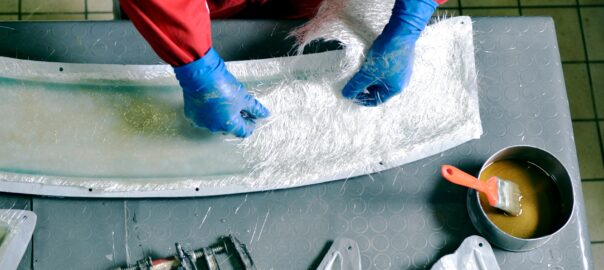Fiberglass Reinforced Plastic (FRP) and Resin Transfer Molding (RTM) are advanced manufacturing processes used to create durable, lightweight composite parts. These methods combine fiberglass reinforcement with a resin matrix to produce strong, corrosion-resistant, and highly customizable products. FRP and RTM are ideal for industries where performance, durability, and the ability to withstand harsh conditions are critical. However, just like any manufacturing process, FRP and RTM have limitations, and understanding when they are most suitable—and when they aren’t—is essential for choosing the right process for your project.
1. When Fiberglass FRP and RTM Are Best Suited
a. High-Strength, Lightweight Parts:
Fiberglass FRP and RTM are ideal for applications where parts need to be lightweight yet incredibly strong. This is why these processes are extensively used in industries like automotive, marine, aerospace, and construction. For example, automotive body panels, boat hulls, and aircraft components benefit from the combination of light weight and structural integrity that FRP and RTM provide. The use of fiberglass composites helps reduce overall weight, which is especially important in transportation industries, where reducing weight can improve fuel efficiency.
b. Corrosion-Resistant Applications:
Fiberglass is inherently corrosion-resistant, making FRP and RTM the perfect choice for industries like chemical processing, wastewater treatment, and marine environments, where exposure to moisture, chemicals, or saltwater is common. Parts like storage tanks, pipes, and boat hulls made with FRP last longer than traditional metal parts, which may corrode or degrade over time. FRP’s resistance to UV radiation and harsh environmental conditions also makes it a durable option for outdoor applications such as bridge components and exterior building panels.
c. Complex Shapes and Low-to-Mid Volume Production:
RTM is especially suitable for creating parts with complex geometries and detailed designs. This process involves injecting resin into a closed mold containing fiberglass reinforcement, resulting in parts that have a smooth surface finish on both sides. For applications that require high precision and fine details—such as aerospace components, automotive panels, or boat doors—RTM provides the ability to create intricate parts with consistent quality. RTM is also a cost-effective option for low-to-mid volume production, where high-quality finishes and durable parts are needed.
d. Large Structural Components:
FRP and RTM are frequently used for producing large structural parts such as wind turbine blades, industrial tanks, and bridge sections. These parts benefit from the lightweight yet strong properties of fiberglass composites, which allow for easier installation, reduced transportation costs, and superior longevity. In construction and infrastructure, FRP is increasingly used to replace heavier materials like steel or concrete in specific applications, reducing overall project costs and maintenance needs.
2. When Fiberglass FRP and RTM May Not Be the Best Option
While FRP and RTM are incredibly versatile and offer numerous benefits, there are situations where they may not be the most suitable manufacturing processes.
a. Small, High-Precision Parts:
FRP and RTM are not well-suited for producing small, intricate parts that require extremely tight tolerances. The tooling costs and material properties make it difficult to produce small components with high precision using these methods. For small, high-tolerance parts like gears, electronic connectors, or medical device components, injection molding or 3D printing would be better alternatives. These processes are better equipped to handle detailed designs and small, high-precision parts that FRP cannot easily achieve.
b. Rapid Prototyping and Low-Volume Runs:
FRP and RTM typically require more setup time and higher tooling costs than other methods, making them less suitable for rapid prototyping or very low-volume production. If you need to produce a few dozen parts or rapidly iterate on designs, 3D printing or urethane casting might be more appropriate. These processes allow for quicker prototyping and easier design modifications, giving manufacturers more flexibility during the early stages of product development.
c. High-Temperature or Heavy-Duty Applications:
While fiberglass composites are strong and resistant to many environmental factors, they may not perform well in extremely high-temperature environments. For parts that will be exposed to high heat, such as engine components or industrial furnace parts, metal fabrication using aluminum, steel, or high-performance thermoplastics like PEEK (polyether ether ketone) or PPS (polyphenylene sulfide) may be better choices. These materials offer superior heat resistance and structural integrity under extreme conditions.
d. Fabrication Limitations for Complex Small Parts:
Although RTM excels at creating larger parts with smooth, complex shapes, it may not be the best option for small, highly detailed parts or parts requiring significant undercuts. For parts that require intricate features or fine details, injection molding or metal casting would likely be more efficient and provide better precision.
3. Types of Fiberglass Manufacturing Processes: FRP and RTM
Understanding the differences between the FRP and RTM processes can help determine which is the best fit for your application.
a. Fiberglass Reinforced Plastic (FRP):
FRP, also known as open-mold fabrication, involves layering fiberglass reinforcement in an open mold, followed by the application of resin to form the part. It is commonly used for large, simple parts such as storage tanks, panels, or marine hulls. FRP is a lower-cost option for large-scale applications but may result in a rougher surface finish on one side of the part.
b. Resin Transfer Molding (RTM):
RTM is a closed-mold process where resin is injected into a mold containing fiberglass reinforcement. This process allows for greater control over material distribution, resulting in parts that have smooth surfaces on both sides. RTM is commonly used for more detailed, high-quality parts like automotive body panels, boat doors, and aerospace components. RTM offers a high-quality finish and is ideal for parts that require both structural integrity and aesthetic appeal.
4. Alternatives to Fiberglass FRP and RTM
There are several alternative manufacturing processes to consider depending on the specific needs of your project.
a. Injection Molding:
For small, high-precision parts with complex geometries, injection molding is a better choice than FRP or RTM. Injection molding excels at producing detailed plastic parts in high volumes with consistent quality and tight tolerances.
b. 3D Printing:
For rapid prototyping and low-volume production, 3D printing offers flexibility and quick design iteration at a lower cost. This method is ideal for creating prototypes, concept models, or parts that require frequent design changes before full-scale production.
c. Metal Fabrication:
For parts exposed to extreme heat or requiring superior structural integrity, metal fabrication using materials like aluminum, steel, or composites can offer better performance than fiberglass. Metal fabrication is used for parts such as engine components, industrial machinery, and aerospace structural parts.
Conclusion
Fiberglass FRP and RTM are excellent choices for manufacturing strong, lightweight, and corrosion-resistant parts, particularly in industries like automotive, marine, aerospace, and construction. These processes are ideal for large structural parts, complex designs, and applications where corrosion resistance is essential. However, for small, intricate parts or rapid prototyping, alternatives like injection molding, 3D printing, or metal fabrication may be more suitable.
Om Raj Tech, through its representation of leading fiberglass manufacturers, offers both FRP and RTM capabilities to deliver high-quality, durable parts for your specific needs. Whether you’re looking for large, structural components or intricate, aesthetically appealing parts, we can connect you with the right solution.
Contact us to explore how we can help you bring your designs to life using fiberglass FRP and RTM manufacturing processes.


